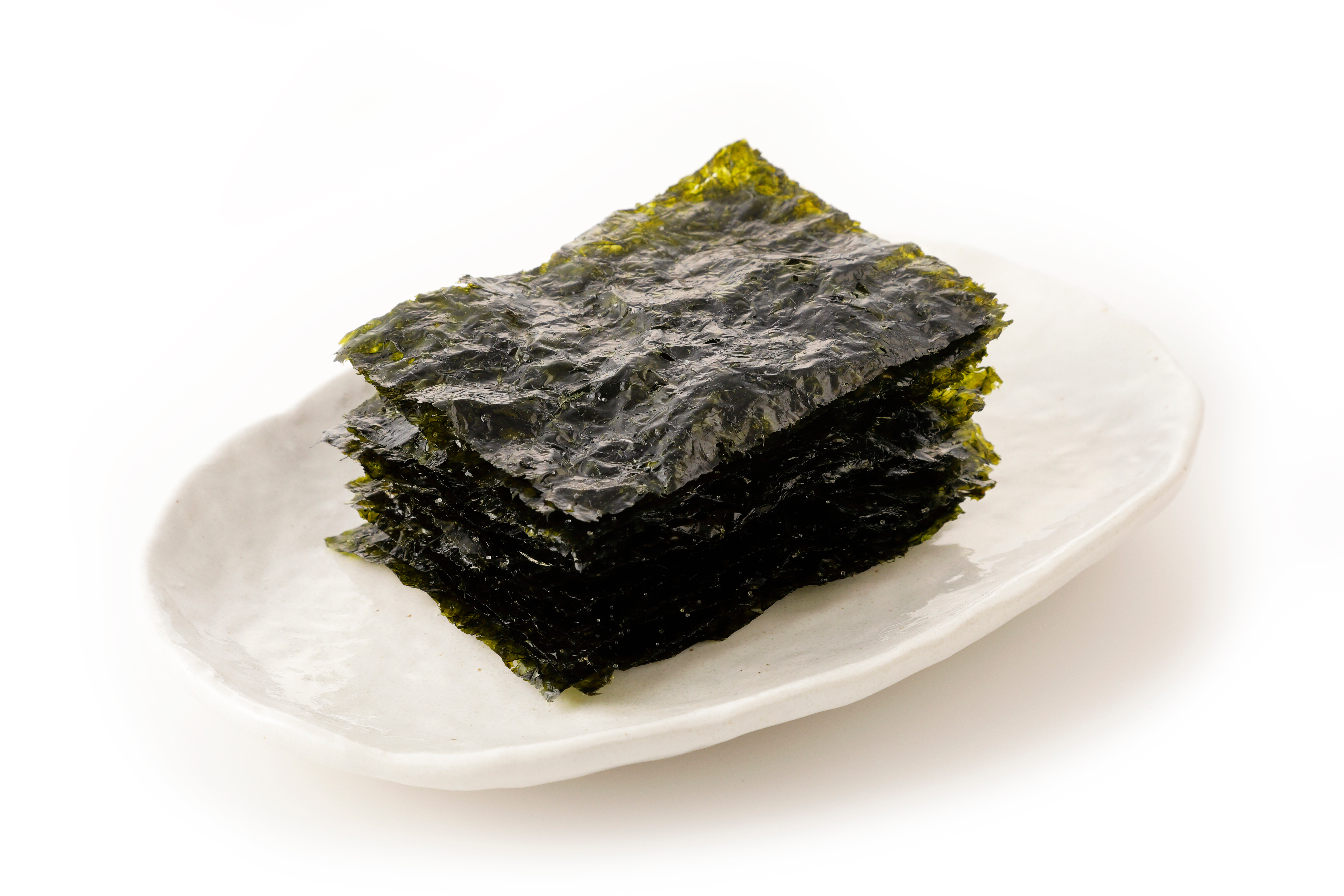
Have you heard of TinyTAN Gim? That’s right: it’s gim snacks with BTS’s characters on them. “Gim?” you ask? Lots and lots of people all over the planet know what gim is now, but it was more a food of curiosity for a long time. Sushi was responsible for introducing gim across the whole world. A number of inventive Japanese chefs devised a clever way to promote sushi in the United States. For Americans, who don’t usually eat raw fish, nothing rawer than smoked salmon (which isn’t even raw once you smoke it)! Ingredients included avocado, fully cooked tuna and mayonnaise. It was the birth of the roll as we know it today, 50 years ago. On top of those rolls, they wanted to sell norimaki, or sushi wrapped in gim, too. But there was no way to get people to eat that “black paper.” Restaurant-goers would joke to the sushi chefs that they weren’t goats. The result was inside-out rolls—a dish where the “black paper” is rolled up and hidden beneath an outer layer of rice.
The gim that was hidden in order to be sold is now making itself known. That BTS’s characters are the mascots for these gim snacks all but guarantees that gim will be a big hit. Gim is also delicious. The New York Times ran an article on March 26 about it, explaining how it is a staple of Korean food and is also be the very embodiment of umami, the key to everyone’s favorite flavors. That savoriness also determines how good steak, fried rice, mandu and udon taste as well. So while it was once believed the tongue could detect only four types of taste, the list has expanded to five to include umami. And gim has umami in spades.
For a while, gim was referred to in the West as nori (のり). There were practically no Westerners who ate it, and so lacking any more suitable name, one was simply loaned from Japanese. It would be pretty awkward to use its scientific name, porphyra. Now fewer and fewer people are referring to it as nori or porphyra—since they can just call it gim. Gim, which is cut into small pieces, slathered/coated with oil that contains the aroma of Korea, roasted, sprinkled with salt and then packaged, is selling monumentally the world over. This kind of gim is known as table gim because it’s designed to be easy to take out and eat right away. Koreans eat more gim than anyone else in the world. Their gim is also the least expensive.
Historically speaking, gim has been well studied on the Korean Peninsula and in Japan, and widely eaten, too. They would remove the seaweed that grows naturally on seaside rocks and dry it. Seaweed is a type of algae. These days, it’s rare to use what’s found stuck to rocks, and there’s no workers collecting it. Instead, it’s mass-produced by experienced aquafarmers. Like plants, seaweed photosynthesizes light. It prefers clear and nutritious seawater at moderate temperatures, only growing well when the water is clean, and, like a young child, is very sensitive, so it won’t grow well if its environment changes in the slightest. Just as green vegetables need tending to by a farmer, seaweed depends on a helping hand. It’s for this reason that the process of growing it is called gim farming. When gim farming is marred by rising water temperatures in winter or unusual plankton growth, the Korean press considers it a major news event. It really shows how important an ingredient gim is in Korea.
There’s an important reason behind gim’s spread across the globe: it’s lightweight. Koreans are now scattered about, living all around the whole world. And a lot of them study abroad. They’re the gim missionaries. Gim isn’t heavy, nor does it take up much space, so they take a lot of it with them. If you go to the home of a Korean born or studying abroad, you may or may not find kimchi, but there’ll be gim without fail. The gim you’ll find there is only about as big as an iPad and very light. Unlike table gim, this kind isn’t seasoned. It’s the very gim used to make that most beloved meal, gimbap. Koreans will keep gim at home, cook up some rice, put whatever they want inside, and bundle it all up into a roll. When a woman in Korea is getting married, it’s common for her mother to buy her daughter a tool specially made for rolling gimbap as part of the wedding preparations. The reason for this is that, although gimbap is often enough purchased from a restaurant, it’s also an indisputable chance for a mother to show off her handiness. All Koreans have a couple memories around gimbap, many of them attached to Mom. On school field trips, moms generally woke up extra early to make gimbap for their child, although these days they’ll often pack them other food instead.
Gimbap is just like the sandwich you might take with you on a picnic, and it makes a light fast-food meal the same way a hamburger does. There are so many gimbap places littered throughout Korean cities that you can easily pick some up to eat any time you want. A good gimbap restaurant carries as much prestige as a Michelin-starred restaurant does, and many chefs dream of achieving stardom on their gimbap-making prowess in much the same way that American cooks seek to dominate the world of burgers by honing their skills. In Korea, at least, gimbap franchises earn far more profit and popularity than McDonald’s. Gimbap is commonplace for Koreans and truly seizes on their tastes. And now, with gimbap being the hottest dish around and new stores opening up every single day, you’ll be able to eat it in your own city, wherever you live in the world. So if there’s ever a gimbap tour in Korea, please come—we’ll be ready to give you all the mouthwatering gimbap you can eat.
-
 © shutterstock
© shutterstock
TRIVIA
How to cook with gim
Gim is a very versatile ingredient. It's produced in droves in Asia and the process is all automated, making it cheap. While gim can be seasoned and eaten as a side dish, it’s also a key ingredient in the exciting food called gimbap. Gimbap is made with gim, rice and some ingredients to fill the middle, but when it comes to expanding upon that recipe, your imagination is the limit. You could use an egg patty as a rice substitute or mix it up by adding whatever local foods are most common where you’re from. You can make it saucy with nước mắm, ketchup, wasabi or barbecue sauce, or even put in some meat if you like. Gimbap has the power to take on any food in the world. Now it’s your turn to make your own gimbap.
Unauthorized reproduction and distribution prohibited.
- [NoW] Modern Korean Cuisine2021.05.14

- [NoW] Korean Barbeque2021.06.11

- [NoW] Fusion food in Korea2021.07.09

- [NoW] Pyongyang naengmyeon season2021.08.06

